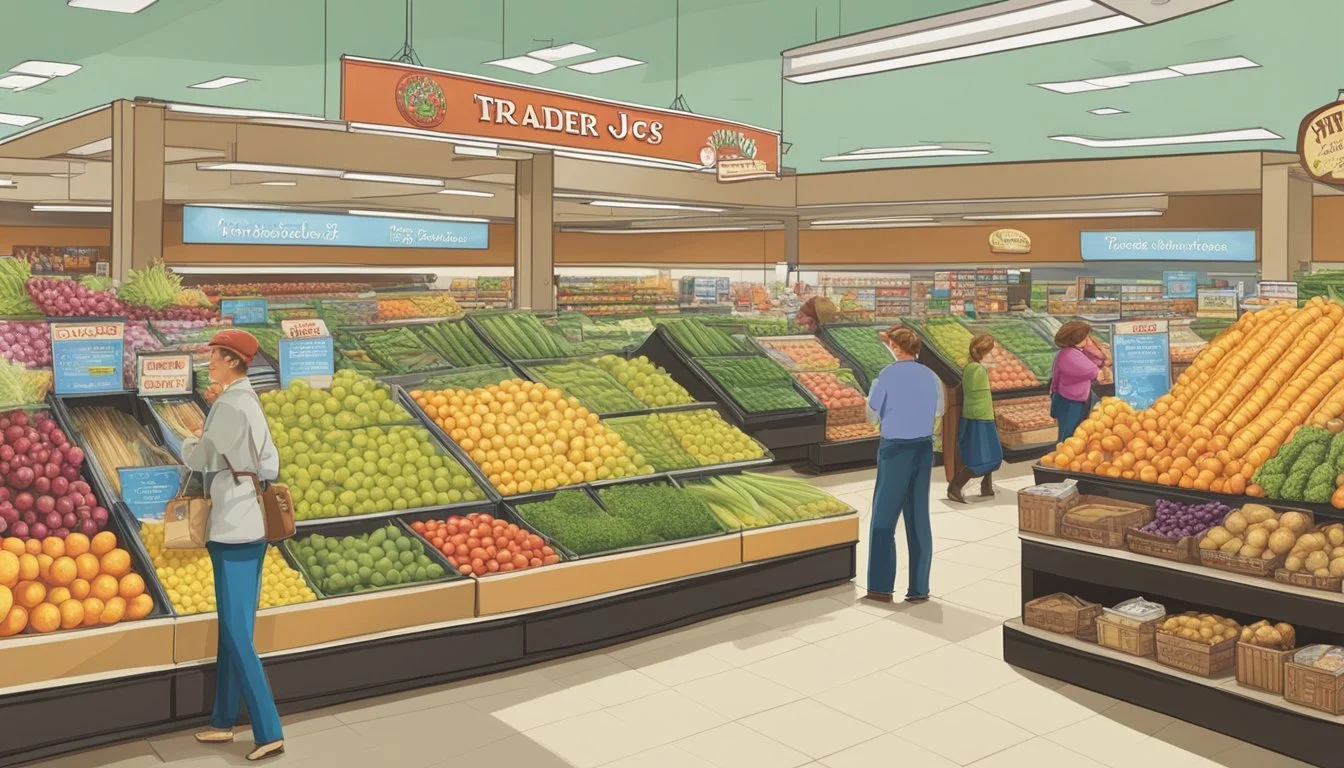Is Trader Joe's Cheaper Than Wegmans?
Analyzing Grocery Store Prices
Part of Our Grocery Store Guide with Details on Trader Joe's Prices and Wegmans Prices
When comparing the pricing strategies of popular American grocery stores, Trader Joe's and Wegmans often find themselves at the forefront of customer discussions. As retail chains known for their dedicated customer bases and unique store brands, both have carved out strongholds in the marketplace. Trader Joe's with its expansive presence of 488 stores nationwide tends to emphasize its line of quirky, proprietary products while Wegmans, though smaller in scale with 101 outlets predominantly in New England, boasts a family-operated legacy and a wide selection of both store brands and national labels.
In conducting a price comparison between the two grocery stores, one must consider the cost of individual items as well as the overall shopping experience. While some products like Greek yogurt and pasta may share equivalence in pricing at both Trader Joe's and Wegmans, there are instances where the former appears to offer lower prices. This is exemplified in reports highlighting Trader Joe's lower cumulative costs for a list of basic staples compared to its competitors.
Customers dedicate their loyalty not only based on price but also on the shopping experience, product quality, and variety. Trader Joe's often markets itself as an affordable option, gaining renown for its cost-effectiveness across a range of products. Wegmans, on the other hand, attracts shoppers with its commitment to customer service and an extensive selection. In determining which grocery store is cheaper, it is essential to go beyond the price tags and factor in these qualitative experiences that shape the consumer's perception of value.
Company Overviews
This section examines the unique trajectories of Trader Joe's and Wegmans. It explores Trader Joe's exceptional brand evolution and Wegmans' strategic market expansion, both critical to their distinct positions in the grocery industry.
Trader Joe's Brand Evolution
Trader Joe's began as a small chain of convenience stores called Pronto Markets in 1958 in California. In 1967, it was renamed Trader Joe's and reimagined as a grocery store that offered an extensive selection of in-house branded products. Over the years, the company has cultivated a cult following due to its unique store design, which includes a nautical theme, and its diverse range of affordable, private-label products. Trader Joe's has expanded its reach with stores nationwide, amassing a significant presence in the grocery industry through its commitment to providing a superior store experience with a distinctive assortment of goods that appeal to a broad customer base.
Wegmans Market Expansion
Wegmans, a family-owned supermarket chain, was founded in 1916 in Rochester, New York. Since then, the company has grown substantially, focusing on expanding its location footprint across the New England and mid-Atlantic regions. As of now, there are over 100 Wegmans stores, and despite a smaller number of outlets compared to Trader Joe's, Wegmans has managed to establish a robust market presence. The brand is known for its large, European open-air market style stores and emphasis on providing an extensive selection of both store brands and name-brand products. Their store designs and attention to customer satisfaction have consistently earned Wegmans industry accolades for creating a superior grocery shopping experience.
Price Analysis
In the competitive grocery market, price is a critical factor for consumers. This section presents a detailed price analysis between two popular stores, Wegmans and Trader Joe's.
Comparing Product Prices
Trader Joe's is renowned for its low prices on a variety of grocery items. According to a Business Insider comparison, certain items like Greek yogurt cups and pasta are equally priced at both Wegmans and Trader Joe's. When it comes to other staples such as cereal, produce, and dairy, Trader Joe's often offers lower price points. For instance:
Greek yogurt: Identical pricing at both retailers.
Whole wheat bread: Trader Joe's tends to have a more affordable option.
Wegmans, while offering a diverse selection and focusing on quality, tends to have higher prices in comparison. A pack of organic mixed peppers was cited at $6.89 at Wegmans versus $4.99 at Trader Joe's. This pattern holds across various categories:
Vegetables & fruit: Trader Joe's typically has lower prices over Wegmans.
Meat & seafood: Wegmans prices higher, often justifying it with a wider selection and specialized items.
Understanding Pricing Strategies
Trader Joe's maintains its reputation for low prices by stocking a large assortment of private label products. Their in-house brand strategy not only reduces costs but also streamlines their inventory, leading to impressive sales per square footage. Wegmans, on the other hand, positions itself differently in the market. Their focus on creating an expansive shopping experience with a vast range of items, including premium and organic offerings, impacts their pricing structure but aims to provide value to customers seeking variety and specialty products. Wegmans' pricing may reflect:
More specialty goods and organic options: Typically priced higher than conventional or private label offerings.
Desire to balance price with selection and quality: Wegmans curates a premium shopping experience.
Both stores are navigating the competitive grocery space by aligning their pricing strategies with their brand philosophies—Trader Joe's with a cost-savings model and Wegmans with a quality and selection-centric approach.
Store Experience Comparisons
When it comes to choosing a grocery store, the shopping experience is just as important as the prices. The layout, ambiance, and customer service excellence set the tone for each visit.
Store Layout and Ambiance
Trader Joe's projects a unique flair with its nautical theme and hand-painted signs, aimed at creating a fun, engaging shopping environment. Its stores are often designed to mimic a European open-air market, providing customers with a sense of discovery and coziness as they browse.
On the other hand, Wegmans tends to offer a more standardized grocery store layout but with a focus on aesthetic, spacious aisles, and a clean atmosphere. Both grocery stores invest in store design and decor to enhance the shopping experience but do so in markedly different styles.
Customer Service Excellence
When it comes to customer service, Trader Joe's employees, known for their exceptional customer service, are easily recognizable in their tropical shirts. They are trained to make personal connections with customers, often sharing product stories or offering tastings.
Wegmans also ranks high in customer service. Their cashiers and staff are noted for being helpful and friendly. Both stores have adapted to the growing trend of online shopping by providing services through partnerships with apps like Instacart for those customers preferring to shop from home. Wegmans and Trader Joe's take great care to ensure both in-store and online customers are met with attentive and efficient service.
Product Variety and Quality
Trader Joe's and Wegmans both provide a vast array of products, with a focus on their own exclusive brands known for quality. Consumers looking at both these grocery chains will find a mix of traditional and unique items tailored to various tastes and dietary needs.
Exclusive Brand Offerings
Trader Joe's is renowned for its in-house brands, encompassing a variety of goods from frozen meals to snacks. These exclusive products often come with distinctive packaging that helps them stand out on the shelves. Wegmans, on the other hand, has its own line of store brand products that span across many categories, from groceries to household items. Both stores emphasize the quality of their private label items, which they assert are comparable to, or even surpass, national brands.
Freshness and Organic Selections
When it comes to fresh produce, Wegmans boasts a robust selection of fresh fruits and vegetables, including organic options. Their produce department is often praised for its wide variety of both organic and conventionally grown items. Meanwhile, Trader Joe's also offers a selection of organic produce, with a focus on quality and freshness. Both stores are committed to providing fresh and high-quality options, catering to health-conscious consumers who prioritize organic food choices.
As patrons navigate the aisles of either store, the commitment of each to quality, whether it’s their store brand offerings or fresh and organic produce, is evident.
Shopping Amenities and Services
Trader Joe's and Wegmans offer distinct shopping amenities and services that enhance the customer experience. These features range from convenient in-store options to a variety of ready-to-eat meals.
Convenience Features
Both Trader Joe's and Wegmans facilitate a convenient shopping experience. Wegmans offers a diverse set of services such as curbside pickup and home delivery options, which are accessible through their partnership with Instacart. Trader Joe's focuses on providing a straightforward in-store experience, streamlining their store layout, and ensuring the availability of everyday essentials.
Customers can enjoy benefits such as:
Home Delivery: Through Instacart, Wegmans extends the convenience of shopping from home, with delivery available for a wide range of products including flowers and bakery items.
In-Store Experience: Trader Joe's aims for a hassle-free, efficient in-store experience with a carefully curated selection of goods.
Prepared Foods and In-Store Dining
When it comes to prepared foods, both Wegmans and Trader Joe's have enticing offerings, but they take different approaches.
Wegmans prides itself on:
Extensive Hot Food Offerings: Customers can find a variety of hot and ready-made takeout options, from pizza to sushi.
Food Hall and Bar: A dining area in many locations where customers can enjoy a meal, such as fresh baked goods from the bakery or a hot food bar.
Trader Joe's specializes in:
Pre-packaged Prepared Foods: An array of ready-to-eat options that are perfect for quick and easy meals.
Unique Prepared Food Selection: Trader Joe’s offers a distinctive selection of globally inspired prepared dishes that cater to various taste preferences, often featuring seasonal ingredients.
Shopper Profiles and Behaviors
Understanding the customers and their shopping behaviors is essential to evaluating whether Trader Joe's is cheaper than Wegmans. This evaluation includes a look at who shops where, along with spending habits and store preferences.
Understanding the Target Customer
Trader Joe's tends to attract customers looking for unique snacks, a casual shopping experience, and eco-friendly options. With a loyal following, their customers prioritize a mix of low prices and quality, often valuing the store's curated selection of household staples, organic produce, and gourmet treats. Wegmans, in contrast, draws in a crowd that appreciates a wide variety of groceries, including premium brands and a larger selection of ready-to-eat meals. Their customer base values the shopping experience Wegmans provides, which includes an emphasis on customer service and a strong regional presence, especially in New England and the mid-Atlantic regions.
Spending Trends and Preferences
Trader Joe's shoppers exhibit a preference for:
Exclusive store brands
Competitive pricing on specific items such as Greek yogurt and pasta
Lower prices on select products compared to Wegmans
Wegmans shoppers tend to spend more on:
Higher-priced items that may offer perceived quality or convenience
Bulk items and a range of personal care products
Both grocery stores have garnered loyal followings who shop based on a combination of savings, product selection, and the overall quality of the shopping experience. While Trader Joe's is recognized for its lower prices on many items, Wegmans customers may find added value in the store's diverse offerings, which can influence their spending behaviors.
Regional Presence and Expansion
Trader Joe's and Wegmans have crafted unique identities within the grocery industry, primarily influenced by their strategic regional presence which affects their pricing and market competition.
Location Impact on Pricing
The relationship between a store's location and its pricing strategy is pivotal. In prime locations like Manhattan's Upper West Side neighborhood, grocery stores may face high operational costs, potentially leading to higher prices. Trader Joe's maintains stores in populous areas such as Manhattan and Brooklyn, leveraging high foot traffic while striving to keep prices competitive. Conversely, Wegmans, predominantly based in New York, also prices its goods by considering local economic factors and the cost of maintaining its sizable, family-friendly stores.
Local Market Competition
Local market competition in areas such as New York City significantly influences the pricing of grocers like Trader Joe's and Wegmans. They compete with other established chains such as Whole Foods and Stop & Shop, pressuring them to provide better value to their customers. Strategic partnerships with local vendors also affect their ability to offer competitive pricing. Trader Joe's and Wegmans navigate this competition by focusing on unique product offerings and in-store experiences, catering to their respective customer bases amidst the bustling grocery industry landscape.
Sustainability and Environmental Initiatives
Trader Joe's and Wegmans are both grocery stores that have committed to environmental stewardship through various sustainability initiatives, focusing on reducing waste and minimizing environmental impact.
Reducing Plastic and Packaging
Trader Joe's is actively working to reduce and remove plastic packaging from its stores. This effort includes initiatives to replace single-use plastics with renewable and recyclable materials. In line with its focus on sustainable operations, Trader Joe's also emphasizes the sale of products in private label packaging which helps in keeping both costs and resource use down.
Wegmans, on the other hand, has introduced measures to minimize packaging, especially plastic usage, across its stores. Both stores encourage the use of reusable bags as an alternative to single-use options, moving towards more environmentally friendly checkout experiences.
Eco-Friendly Store Policies
Trader Joe's maintains sustainability as a cornerstone of its operations. Stores tend to be smaller than typical supermarkets, which can lead to reduced energy consumption. Additionally, they have implemented policies to use paper bags made from renewable resources, reflecting their commitment to environmental responsibility.
Wegmans also focuses on sustainable efforts, such as offering brown paper bags, which are easily compostable or recyclable. Furthermore, Wegmans has opted for designs that eschew the standard supermarket frills, instead adopting layouts and operational policies that favor energy efficiency and reduced waste.
Both Trader Joe's and Wegmans recognize the importance of not only providing affordable groceries but also in doing so through eco-friendly practices that contribute positively to the environment.
Final Comparison and Recommendations
When comparing Trader Joe's and Wegmans, price and selection emerge as key factors. Trader Joe's often offers lower prices on a variety of items such as organic produce and grocery staples. For instance, a Wegmans pack of organic peppers may be priced higher compared to Trader Joe's equivalent offering.
Wegmans, on the other hand, is recognized for an extensive selection that surpasses Trader Joe's inventory. It caters to a broader range of tastes and dietary needs with a multitude of brands and products on its shelves. Customers commend Wegmans for its quality and variety, although this might be reflected in the prices.
In terms of store experience and customer service, both retailers have dedicated followings. Wegmans often receives praise for its store layout and the overall shopping experience, which includes a variety of in-store dining options and a family-friendly environment. Trader Joe's is celebrated for its unique product offerings and efficient customer service, which contribute to a positive shopping atmosphere.
Regarding quality, both stores are committed to offering high-quality products, with Trader Joe's focusing heavily on its private label to ensure consistency.
For shoppers prioritizing cost-saving, Trader Joe's is likely the better choice. Those favoring a wider selection, superior store experience, and customer service may find Wegmans to be worth the additional cost. Consumers must consider their specific preferences when choosing between the two grocers.
Trader Joe's Wegmans Pricing Lower Higher Selection Limited Extensive Store Experience Efficient Comprehensive Customer Service Quick Attentive Quality Consistent Varied







